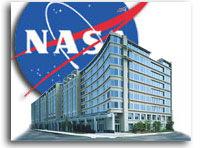NASA's Accounting Improves But Its Cost Forecasting Does Not

NASA Receives Fifth Consecutive Clean Audit Opinion
“NASA has received an unmodified audit opinion on its Fiscal Year 2015 (FY 2015) financial statements, marking the fifth consecutive year of “clean” opinions. The agency has released its FY 2015 Agency Financial Report (AFR), which provides details on its financial results and performance highlights. The auditor’s unmodified opinion is that NASA’s financial statements fairly present the agency’s financial position and results of operations. An unmodified opinion is the highest audit opinion that may be received from an external auditor.”
2015 Report on NASA’s Top Management and Performance Challenges, NASA OIG
“We believe the Agency’s estimate that it will cost between $3 and $4 billion annually to operate the Station is based on overly optimistic assumptions, and that for a number of reasons costs are likely to be higher. … Although the NASA Authorization Act of 2010 set a goal for NASA to achieve operational capability for the SLS and Orion by December 31, 2016, NASA will not meet this timetable. Noting technical and funding uncertainties, NASA has adjusted its planning schedule to reflect an SLS launch readiness date of no later than November 2018, with the first crewed flight of Orion expected no later than 2023.”
NASA Office of Inspector General’s Semiannual Report to Congress April 1 – September 30, 2015
“As we head into December, the unfortunate pattern of the Federal Government beginning a new fiscal year without an approved budget has repeated itself with a continuing resolution funding NASA through the middle of the month. Failure to receive a full-year appropriation compounds the challenges facing Agency leaders in effectively managing NASA’s varied programs, perhaps most prominently its plans to transport astronauts to the International Space Station on commercial U.S. vehicles by late 2017. Given its importance, the Office of Inspector General initiated a follow-up audit this reporting period that will examine the status of the Agency’s Commercial Crew Program.”






‘Between $3 and $4 billion’? Let’s see, isn’t that- well, isn’t that a $billion dollar difference? After 15 years the estimate is either 25% or 33% off?
I wonder what sort of unknowns could account for this huge swing.
The number of crew and cargo flights that will be allowed?
There is a breakdown of the unknowns and projected costs in the full report if you click the link above the executive summary.
Missed it. Thanks.
In commercial industry cost overruns are fairly common in developing new technology, i.e. the Boeing 787, which ran four years over schedule. But the operating cost predictions, showing a significant cost reduction compared to the previous generation of airliners, were relatively accurate, indeed had this not been the case the entire project would have failed.
Difficulty in predicting operational costs in human spaceflight can be seen as far back as the beginning of the Shuttle program, which had operational costs about ten times the original predictions. These problems stem in part from the incentive to underestimate cost at both the agency and contractor level so as to get a programmatic commitment.
Added to this has been failure to anticipate and include the complexities of the task, especially facility operations and overhead, and the time and complexity of ground processing. Although this was a major problem with Shuttle, some expendables such as Delta IV had similar failures to properly model the complexity and cost of ground processing.
A third problem is the tendency of Congress to focus support only on major programs, while there is limited support for hundreds of smaller R&D efforts which are forced to piggyback on major programs. The questioning of “cross agency support” is a sign of this.
Finally there is the cost of the many organizational interfaces and multiple management chains maintained by multiple NASA centers and contractors. The Commercial program has shown considerable imagination and perseverance in keeping the operational responsibilities entirely within SpaceX and Boeing, respectively.
25% difference – if this was private industry, the estimators would be estimating the number of people they will have to follow in the unemployment line. All this shows that government estimators have no clue what things actually cost.
It’s so easy to criticize NASA in the cost arena, but as others have pointed out, not entirely fair. The cost of developing and operating a ‘space airplane’ seen from 1970s eyes? Without experience, and in fact no real direct experience anywhere?
Indeed that’s where NASA finds itself so often- out on a ledge trying to do truly great things- the space telescopes come to mind, all of them, including the Webb. For my money, and it is my money in very small part, I applaud the efforts, and while I do want accountants watching, I don’t want them driving.
I wasn’t talking about cost growth. I was talking about the base estimate – “…between $3 and $4 billion…”